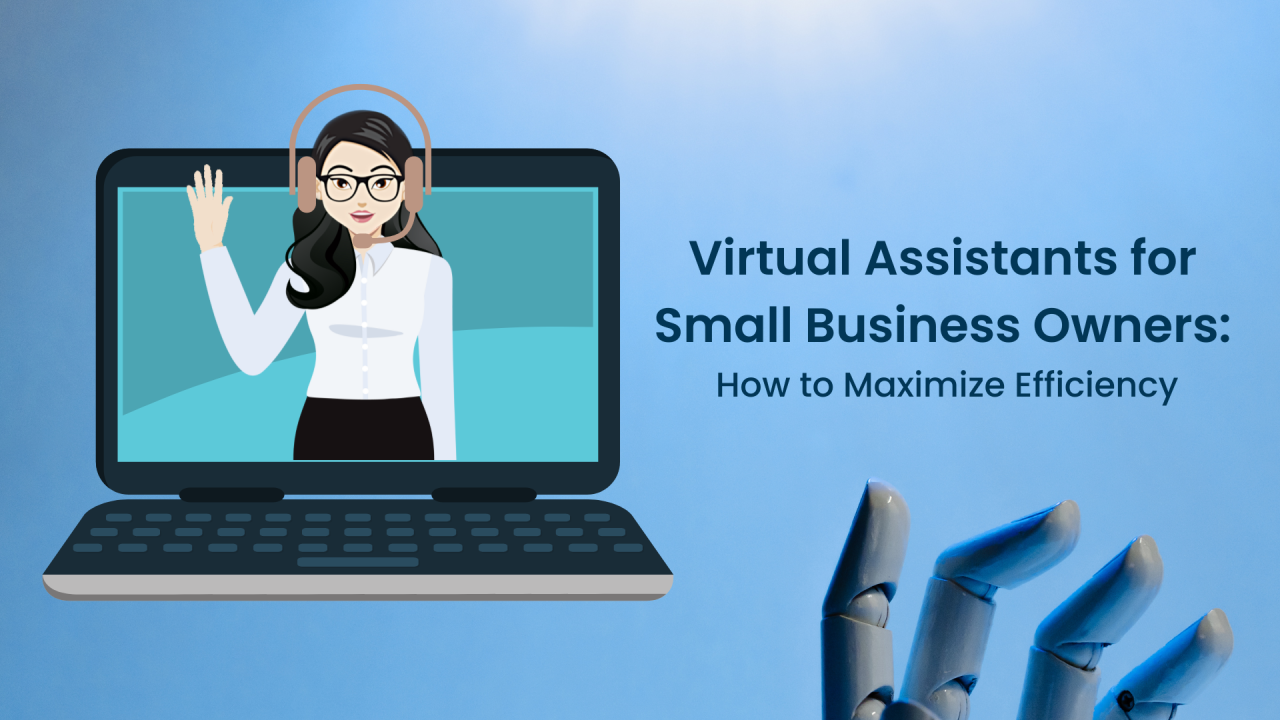|
In the realm of small businesses, where resources are often tight and every task matters, the role of virtual assistants (VAs) has emerged as a game-changer. These professionals, working remotely and equipped with a diverse skill set, have a profound impact on transforming mundane tasks into significant triumphs for small businesses.
Firstly, VAs alleviate the burden of administrative tasks that can bog down entrepreneurs. From managing emails and scheduling appointments to handling customer inquiries, VAs free up valuable time for business owners to focus on core activities like strategy, innovation, and growth. This streamlined approach not only increases productivity but also enhances overall business efficiency. Moreover, virtual assistants bring specialized expertise to the table. Whether it's digital marketing, social media management, graphic design, or content creation, VAs often possess niche skills that complement the business's needs. This access to specialized talent allows small businesses to access professional services without the overhead costs associated with hiring full-time employees. Furthermore, VAs contribute to scalability and flexibility within small businesses. As workload fluctuates or new projects emerge, virtual assistants can easily adapt to these changes. They offer a scalable solution that allows businesses to adjust their support levels based on demand, making them an invaluable asset during growth phases or seasonal fluctuations. Additionally, VAs foster innovation and creativity within small businesses. Their fresh perspective and diverse experiences can lead to novel ideas, improved processes, and innovative solutions to challenges. By collaborating with virtual assistants, small businesses can tap into a pool of creativity that ignites progress and drives success. In essence, virtual assistants play a pivotal role in elevating small businesses from merely managing tasks to achieving remarkable triumphs. Their impact extends beyond routine operations, empowering entrepreneurs to focus on strategic initiatives, capitalize on opportunities, and navigate the competitive landscape with agility and efficiency.
0 Comments
In today's fast-paced and competitive business landscape, efficiency and productivity are paramount for success. As entrepreneurs and business owners juggle multiple tasks and responsibilities, finding ways to streamline operations and focus on core business activities becomes essential. This is where virtual assistant services come into play, offering a powerful solution to elevate your business and maximize productivity.
Virtual assistant services provide a range of benefits that can transform the way you operate and lead to significant growth. Here are some key advantages of leveraging virtual assistant services for your business: Increased Efficiency: Virtual assistants can handle routine tasks such as email management, scheduling appointments, data entry, and more. By delegating these tasks, you free up valuable time to focus on strategic activities that drive growth and revenue. Cost-Effective Solution: Hiring virtual assistants is a cost-effective alternative to hiring full-time employees. You save on overhead costs such as office space, equipment, and benefits while accessing skilled professionals who work remotely. Scalability: Virtual assistant services offer scalability, allowing you to adjust the level of support based on your business needs. Whether you need assistance on a project basis or ongoing support, virtual assistants can adapt to your requirements. Flexibility and Accessibility: Virtual assistants work remotely, providing you with flexibility in terms of working hours and accessibility. This ensures that tasks are handled efficiently, even outside traditional office hours. Specialized Skills: Virtual assistant services offer access to a diverse talent pool with specialized skills in various areas such as administrative support, marketing, customer service, social media management, and more. You can choose virtual assistants with the expertise that aligns with your business needs. Focus on Core Activities: By outsourcing non-core tasks to virtual assistants, you can focus your energy and resources on core business activities such as strategy development, business expansion, and client relationship management. In conclusion, virtual assistant services offer a strategic advantage for businesses looking to enhance efficiency, reduce costs, and achieve scalable growth. By leveraging the power of virtual assistants, you can elevate your business operations and unlock new opportunities for success in today's dynamic business environment. In today's dynamic business landscape, where agility and efficiency are paramount, virtual assistants (VAs) have emerged as invaluable assets for businesses of all sizes. These remote professionals play a crucial role in navigating the path to success. Let's delve into the key ways in which virtual assistants contribute to business growth and productivity.
Firstly, VAs offer unparalleled flexibility. Unlike traditional employees, they can work from anywhere, anytime, making them ideal for businesses with global operations or remote teams. This flexibility allows businesses to scale up or down as needed without the constraints of physical office spaces or geographical limitations. Secondly, virtual assistants bring a diverse skill set to the table. From administrative tasks like scheduling meetings and managing emails to specialized functions such as digital marketing, content creation, and customer support, VAs cover a wide range of responsibilities. Their expertise across multiple domains adds immense value to businesses looking to streamline operations and focus on core activities. Moreover, virtual assistants contribute to cost savings. By hiring remote professionals, businesses can avoid overhead costs associated with office space, equipment, and employee benefits. VAs typically work on a contract or freelance basis, allowing businesses to access top talent without the financial commitments of full-time employment. Another crucial aspect is time management. Virtual assistants excel in managing tasks efficiently, prioritizing deadlines, and ensuring smooth workflow. Their ability to handle multiple responsibilities simultaneously frees up valuable time for business owners and executives to focus on strategic decision-making and business growth initiatives. In conclusion, virtual assistants play a pivotal role in today's business landscape by offering flexibility, diverse skill sets, cost-effectiveness, and efficient time management. Embracing the services of virtual assistants empowers businesses to navigate challenges, seize opportunities, and achieve sustained success in a competitive environment In the ever-evolving landscape of modern business, efficiency has become synonymous with success. Companies are constantly seeking innovative ways to streamline processes, boost productivity, and stay ahead of the competition. One such solution that has gained significant traction is the utilization of virtual assistants (VAs). These skilled professionals offer a wide range of services that can greatly enhance organizational efficiency and effectiveness.
One of the primary ways VAs maximize productivity is through task delegation. By offloading repetitive and time-consuming tasks such as data entry, email management, scheduling, and research, business owners and executives can focus their time and energy on high-priority activities that drive growth and innovation. This strategic delegation not only frees up valuable resources but also ensures that tasks are completed efficiently and accurately. Moreover, VAs bring a level of flexibility and scalability to businesses. Whether it's handling overflow work during peak periods, supporting special projects, or providing ongoing administrative support, VAs can adapt to varying workloads and business needs. This scalability allows organizations to scale up or down without the overhead costs and complexities associated with hiring full-time employees. Furthermore, VAs leverage technology and digital tools to streamline workflows and communication. With access to cloud-based platforms, project management tools, and communication software, VAs can collaborate seamlessly with internal teams and external stakeholders, regardless of geographical locations. This digital infrastructure not only enhances efficiency but also promotes agility and responsiveness in today's fast-paced business environment. Additionally, VAs bring a fresh perspective and diverse skill set to the table. Many VAs specialize in niche areas such as social media management, digital marketing, graphic design, and customer support. This specialized expertise allows businesses to leverage the latest industry trends and best practices, driving innovation and staying ahead of competitors. In conclusion, virtual assistants play a pivotal role in unleashing efficiency within organizations. Through task delegation, scalability, digital integration, and specialized expertise, VAs empower businesses to optimize productivity, drive growth, and achieve their strategic objectives. Embracing virtual assistance is not just a trend but a strategic imperative for businesses looking to thrive in today's dynamic business landscape. In today's fast-paced digital age, businesses are constantly seeking ways to optimize their operations and stay ahead of the competition. One of the most impactful strategies that modern businesses are embracing is hiring virtual assistants (VAs). Virtual assistants, also known as remote assistants or virtual office assistants, offer a wide range of services that can significantly transform how a business operates.
One of the primary advantages of hiring a virtual assistant is the flexibility they provide. Unlike traditional in-house employees, virtual assistants work remotely, which means businesses can access a global talent pool and find the right expertise without being limited by geographical constraints. This flexibility also extends to work hours, as virtual assistants can work across different time zones, allowing for round-the-clock productivity and support. Another key benefit of virtual assistants is cost-effectiveness. By hiring virtual assistants, businesses can save on overhead costs associated with in-house employees, such as office space, equipment, and benefits. Virtual assistants are typically independent contractors, which means businesses only pay for the services they need, whether it's on an hourly, project-based, or retainer basis, making it a cost-efficient solution for businesses of all sizes. Virtual assistants are also highly skilled professionals who can handle a wide range of tasks, from administrative and customer support to digital marketing, content creation, and more. This versatility allows businesses to delegate non-core tasks to virtual assistants, freeing up valuable time for core business activities and strategic initiatives. Additionally, virtual assistants can improve productivity and efficiency by leveraging their expertise and using tools and technologies to streamline processes. They can handle repetitive tasks, manage calendars and schedules, conduct research, handle emails and correspondence, manage social media accounts, and perform a variety of other tasks that contribute to smoother business operations. In conclusion, hiring a virtual assistant can be a game-changer for businesses looking to optimize their operations, increase productivity, reduce costs, and stay competitive in today's dynamic business environment. The virtual advantage offered by virtual assistants is undeniable, making them a valuable asset for businesses seeking transformative solutions. |
|






